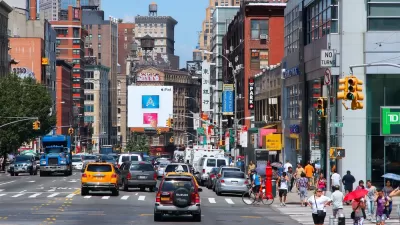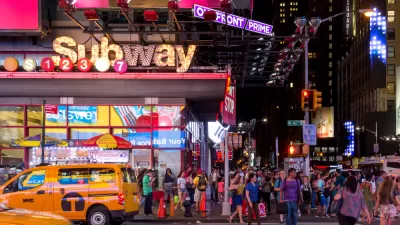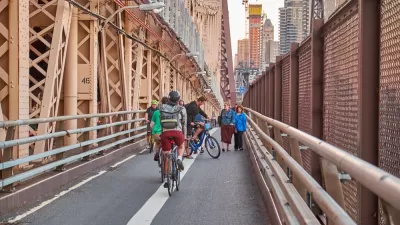Gov. Andrew Cuomo (D-N.Y.) appears to be backing away from a controversial plan to toll midtown Manhattan but shows no reservations about embracing land value capture, which some regard as a "taking" by taxing land proximate to subway stations.

In Govenor Andrew Cuomo's eyes, taxes are presumably less controversial than the tolls outlined in the Fix NYC report, which he received in January, that would provide revenue to repair the subway as well as reduce congestion in midtown. While not initially received well by New York City Mayor Bill de Blasio, he has since warmed to it, so it might have been disappointing to learn of the governor's change in direction.
"Draft legislation acquired by POLITICO, which two sources say is being peddled by the Cuomo administration, would demarcate huge swaths of Manhattan and the Bronx as 'transportation improvement districts,' and allow the state-run Metropolitan Transportation Authority to take property tax revenue from those districts that it claims is generated by transit improvements as far as a mile away," reports Dana Rubinstein for POLITICO New York on March 23.
Major transit improvements typically enhance neighboring property values, and "value capture" refers to the concept of capturing part of that extra value and using it to pay for the transit improvement in question. The city is using the technique to pay for the extension of the 7 train to the far West Side . It's also using it to pay for transit improvements in East Midtown [see New York Post op-ed below].
However, the #7 line extension used value capture, also referred to as tax increment financing, at the behest of then-Mayor Michael Bloomberg. Furthermore, it funded a 1.5-mile extension and the new Hudson Yards subway station. Cuomo wants to use the taxes to repair the current system.
“It is [the] unprecedented taking of the city tax base ... without the local government participating in the decision," said Dean Fuleihan, New York City’s first deputy mayor, in an interview [March 20], adding that the legislation would, wrest “billions” from New York City,
"While value capture makes sense in theory, any such arrangement should be tailored to specific projects and circumstances," opines Carol Kellermann, president of the Citizens Budget Commission, for City & State on March 21.
Instead, the current proposal broadly claims increases in property values around subway stations are or will be attributable to transit improvements and asserts the right of the MTA to apportion city revenues, usurping the city’s control over its own tax dollars.
That opinion is shared by Eric Kober, a senior research scholar at New York University’s Rudin Center for Transportation Policy and Management, who writes in a new report on value capture used for transit [pdf] that the first iteration of Cuomo's proposal “diverts New York City’s largest and most stable tax source in a manner that could affect the City’s fiscal stability,” adds Rubinstein.
Similarly, a March 18 New York Post op-ed by MTA board member Carl Weisbord and Nicole Gelinas, a Manhattan Institute senior fellow, acknowledge the benefits of value capture but are critical of the governor's proposal. In addition to the #7 subway extension, they note:
The de Blasio administration has used another form of value capture with the MTA. It rezoned the Vanderbilt Corridor to allow property owners greater development rights in return for improvements to subways... And de Blasio’s recently enacted East Midtown rezoning will ultimately add about $500 million more in subway-station improvements throughout East Midtown.
We need better transit, and value capture may have a continued role in helping to finance it, along with ideas that do require state legislation, such as congestion pricing. But that requires the MTA to work in partnership with the city’s elected officials, who answer to city residents and who have thus always been responsible for the allocation of the city’s precious real-estate tax stream.
More on Fix NYC
One thing value capture will definitely not do is mitigate traffic congestion, the major benefit of congestion (or cordon area) pricing in addition to generating new revenue.
While Cuomo shows no sign of supporting Fix NYC's recommended $11.52 toll for passenger vehicles or $25.34 for trucks charged weekdays from 6 AM to 8 PM to enter Manhattan south of 60th Street, or any toll, for that matter, POLITICO's Rubenstein and Jimmy Vielkind report on March 23 that the governor is backing the third revenue measure in the cordon area pricing plan: a surcharge on for-hire vehicles including taxis and ride-hailing vehicles, described extensively, though only for transportation network companies, last December in the Times by Winnie Hu.
A cautionary note by Joe Cortright of City Observatory, who views it as a "dangerous half-measure," writes Planetizen contributor Casey Brazeal on March 8.
Hat tip to Myer Horn via University of Minnesota Congestion Pricing Forum.
Correspondent's note: Recommended reading on value capture – commentary by Anthony Flint of the Lincoln Institute of Land Policy in City & State, March 11: "How value capture can save New York City’s subways: Why it works, and how it should be used"
FULL STORY: With congestion pricing on sidelines, Cuomo doubles down on controversial subway-funding measure

Planetizen Federal Action Tracker
A weekly monitor of how Trump’s orders and actions are impacting planners and planning in America.

Maui's Vacation Rental Debate Turns Ugly
Verbal attacks, misinformation campaigns and fistfights plague a high-stakes debate to convert thousands of vacation rentals into long-term housing.

San Francisco Suspends Traffic Calming Amidst Record Deaths
Citing “a challenging fiscal landscape,” the city will cease the program on the heels of 42 traffic deaths, including 24 pedestrians.

Amtrak Rolls Out New Orleans to Alabama “Mardi Gras” Train
The new service will operate morning and evening departures between Mobile and New Orleans.

The Subversive Car-Free Guide to Trump's Great American Road Trip
Car-free ways to access Chicagoland’s best tourist attractions.

San Antonio and Austin are Fusing Into one Massive Megaregion
The region spanning the two central Texas cities is growing fast, posing challenges for local infrastructure and water supplies.
Urban Design for Planners 1: Software Tools
This six-course series explores essential urban design concepts using open source software and equips planners with the tools they need to participate fully in the urban design process.
Planning for Universal Design
Learn the tools for implementing Universal Design in planning regulations.
Heyer Gruel & Associates PA
JM Goldson LLC
Custer County Colorado
City of Camden Redevelopment Agency
City of Astoria
Transportation Research & Education Center (TREC) at Portland State University
Jefferson Parish Government
Camden Redevelopment Agency
City of Claremont





























